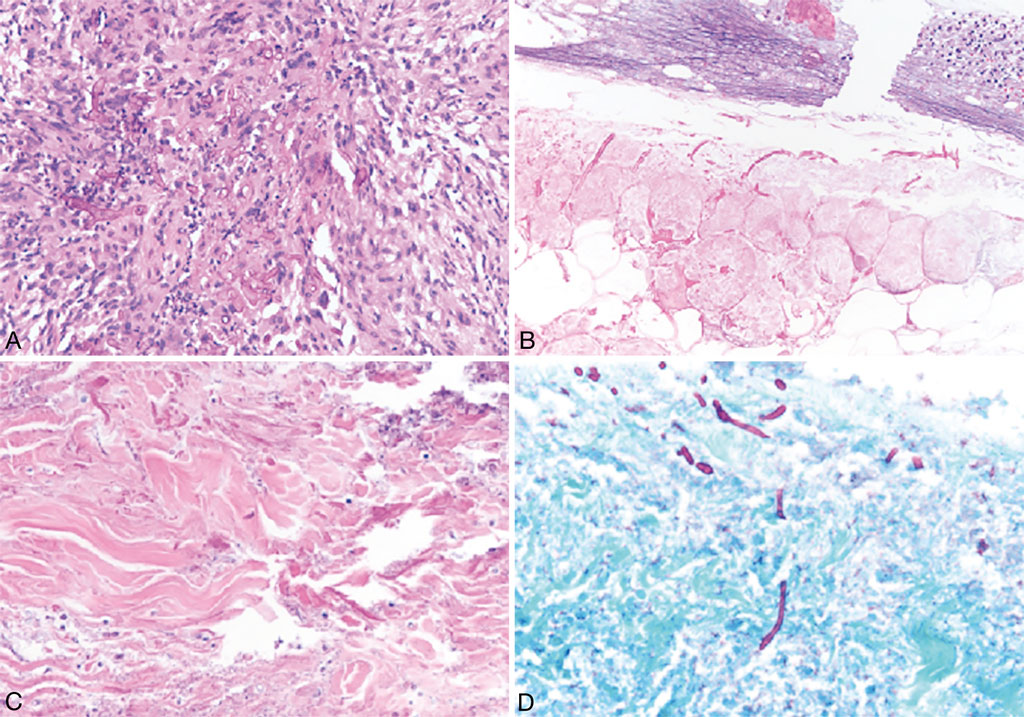Intraoperative Frozen Section Detect Acute Invasive Fungal Rhinosinusitis
By LabMedica International staff writers
Posted on 09 Jun 2021
Acute invasive fungal rhinosinusitis (AIFRS) is a potentially lethal and rapidly progressive disease. It primarily affects immunocompromised or diabetic patients, in whom organisms that are ubiquitous, but usually harmless can invade mucosa and rapidly disseminate to the orbit and cranial cavity.Posted on 09 Jun 2021
Diagnostic delay is a factor that has consistently been associated with poor outcome in AIFRS, and this, in part, is related to the fact that AIFRS remains a histopathologic diagnosis. The clinical features are nonspecific, and sinus computed tomography is limited by lack of sensitivity for early AIFRS and poor specificity thereafter.

Image: (A) Mucormycetes demonstrated broad hyphae with wavy, nonparallel walls and few septa. (B) Nonmucormycetes, which were predominantly Aspergillus species by culture, demonstrated thin delicate hyphae with parallel walls and frequent septa. (C and D) Candida species were distinctive for a mixture of yeasts and pseudohyphae (Photo courtesy of UT Health San Antonio)
Medical Laboratorians at the UT Health San Antonio (San Antonio, TX, USA) retrospectively reviewed all cases of clinically suspected AIFRS during a 10-year period. Frozen-section samples were received fresh from the operating room, embedded in optimal cutting temperature medium, and allowed to freeze within a cryostat at an approximate temperature of −20 °C. Biopsies were entirely embedded when size permitted. Sections were prepared using a Leica Biosystems cryostat (Nußloch, Germany), at a thickness of approximately 5 μm, across two different levels. These were stained with hematoxylin and eosin (H&E) and interpreted by the general surgical pathologist on-call for frozen sections. The frozen-section results were compared with the final permanent sections as well as the tissue fungal culture results, following which the accuracy of frozen section was determined.
The team reported that 48 patients with 133 frozen-section evaluations for AIFRS were included in the study. Thirty of 48 patients and 61 of 133 specimens were positive for AIFRS on final pathology. Of 30 positive patients, 27 (90%) had at least one specimen diagnosed as positive during intraoperative consultation; among the 61 positive specimens, 54 (88.5%) were diagnosed as positive during intraoperative consultation. Of 72 negative specimens, all were interpreted as negative on frozen section. Thus, frozen sections had a sensitivity of 88.5%, specificity of 100%, positive predictive value of 100%, and negative predictive value of 90.6%.
The authors concluded that the decision to undertake surgical debridement in patients with AIFRS requires definitive histopathologic diagnosis, for which intraoperative consultation with frozen section may be requested. Their analysis has demonstrated overall high accuracy of frozen sections in this scenario, and this information may be valuable in the surgical management of these patients. The study was published in the June, 2021 issue of the journal Archives of Pathology and Laboratory Medicine.
Related Links:
UT Health San Antonio
Leica Biosystems














